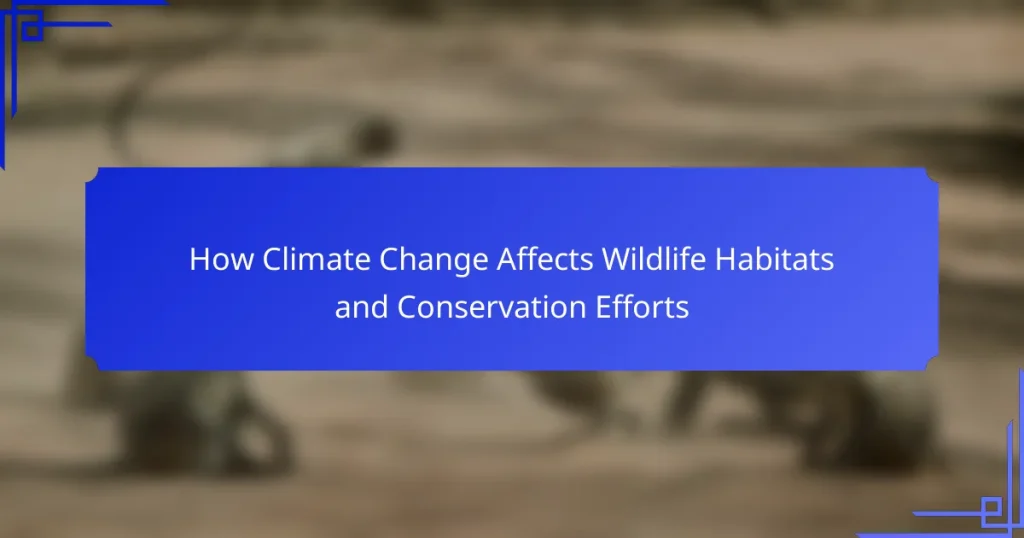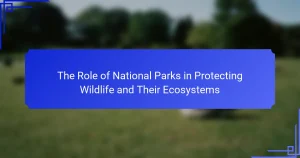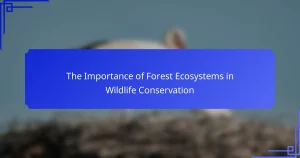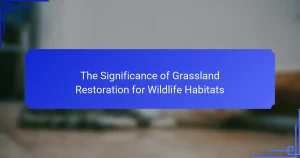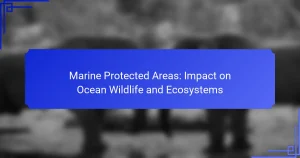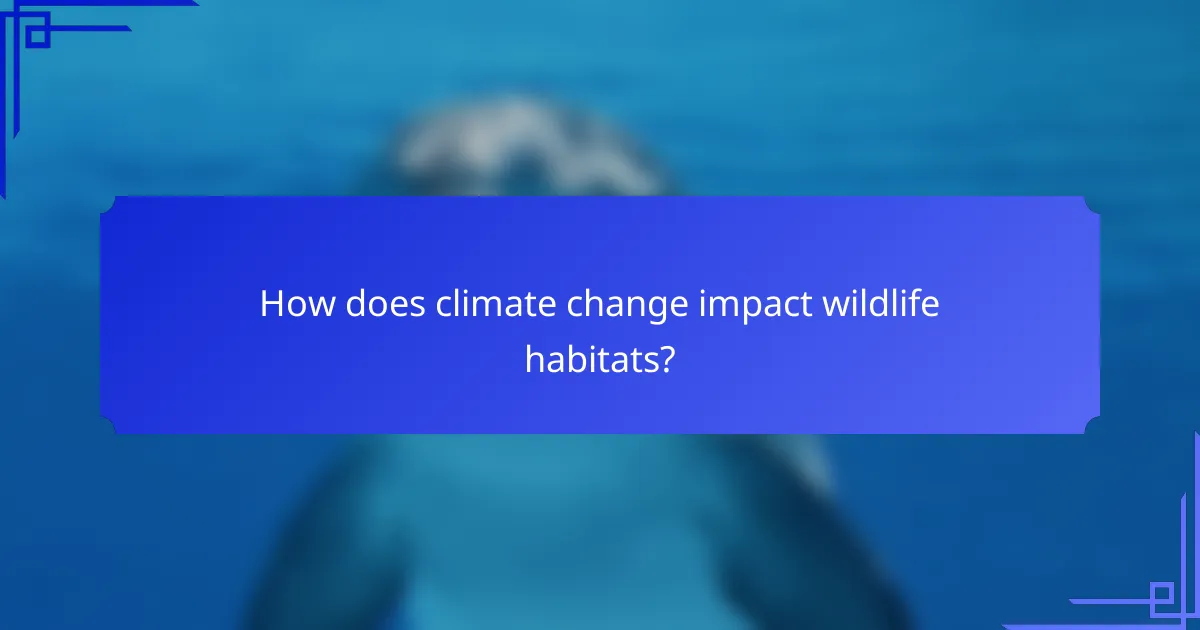
How does climate change impact wildlife habitats?
Climate change significantly impacts wildlife habitats by altering temperature and precipitation patterns. These changes affect food availability and breeding cycles for many species. For example, warmer temperatures can lead to habitat loss, particularly in polar and mountainous regions. Additionally, changes in rainfall can result in droughts or flooding, further disrupting ecosystems. The National Wildlife Federation reports that over 30% of species are at risk due to habitat changes caused by climate change. This loss of habitat can lead to decreased biodiversity and increased competition among species for resources.
What are the primary effects of climate change on ecosystems?
Climate change primarily affects ecosystems by altering temperature and precipitation patterns. These changes disrupt species distribution and migration. Many species struggle to adapt to rapid environmental shifts. Some ecosystems face increased frequency of extreme weather events. Coral reefs experience bleaching due to rising ocean temperatures. Altered ecosystems can lead to loss of biodiversity. Changes in habitat can threaten food sources for various species. Invasive species may thrive in new conditions, outcompeting native species.
How does temperature change affect species distribution?
Temperature change significantly affects species distribution. As temperatures rise, many species shift their ranges toward cooler areas, typically poleward or to higher elevations. This shift occurs because species have specific temperature tolerances that influence their survival and reproduction. For example, studies show that many bird species in North America have moved northward by an average of 30 miles over the past few decades. Similarly, marine species are migrating to deeper, cooler waters due to ocean warming. These changes can disrupt existing ecosystems and lead to increased competition for resources. In some cases, species unable to migrate may face extinction. Overall, temperature change is a critical factor in determining where species can thrive.
What role does precipitation variability play in habitat stability?
Precipitation variability significantly affects habitat stability. It influences water availability, which is crucial for plant and animal life. Fluctuations in rainfall can lead to droughts or flooding. These extremes can disrupt ecosystems and alter species distributions. For example, droughts can lead to reduced plant growth, impacting herbivores and their predators. Conversely, excessive rainfall can cause soil erosion and habitat destruction. Studies show that regions with high precipitation variability experience greater biodiversity loss. This loss can destabilize food webs and reduce ecosystem resilience.
Why are certain habitats more vulnerable to climate change?
Certain habitats are more vulnerable to climate change due to their specific ecological characteristics. These habitats often have limited adaptability to changing conditions. For example, coastal ecosystems face rising sea levels and increased salinity, making them susceptible to habitat loss. Similarly, alpine environments are sensitive to temperature changes, affecting species that rely on cold conditions.
Moreover, habitats with low biodiversity may struggle to withstand climate impacts. A lack of diverse species reduces resilience against disturbances. Wetlands, which act as natural buffers, can be overwhelmed by extreme weather events.
Research indicates that regions like coral reefs are particularly at risk due to ocean acidification and warming waters. These factors lead to coral bleaching, threatening marine biodiversity. The Intergovernmental Panel on Climate Change (IPCC) reports that many ecosystems are approaching critical thresholds that could lead to irreversible changes.
What characteristics make a habitat susceptible to changes?
Habitats are susceptible to changes due to various characteristics. These include biodiversity levels, geographic location, and climate stability. High biodiversity can enhance resilience against changes. Conversely, low biodiversity can lead to vulnerability. Geographic location affects exposure to climate extremes. Areas near coasts may face rising sea levels. Climate stability is crucial; fluctuating temperatures can disrupt ecosystems. Human activities, like deforestation, further exacerbate habitat susceptibility. For example, research shows that fragmented habitats are less resilient to environmental changes.
How do human activities exacerbate habitat vulnerability?
Human activities exacerbate habitat vulnerability through pollution, deforestation, urbanization, and climate change. Pollution introduces harmful substances into ecosystems, degrading air and water quality. Deforestation removes trees that provide shelter and food for wildlife, disrupting entire ecosystems. Urbanization transforms natural landscapes into cities, fragmenting habitats and isolating wildlife populations. Climate change, driven by human actions, alters temperature and precipitation patterns, affecting species survival. These factors collectively increase the stress on habitats, making them less resilient to environmental changes. For instance, habitat loss due to urban sprawl has been linked to a 30% decline in biodiversity in affected areas.
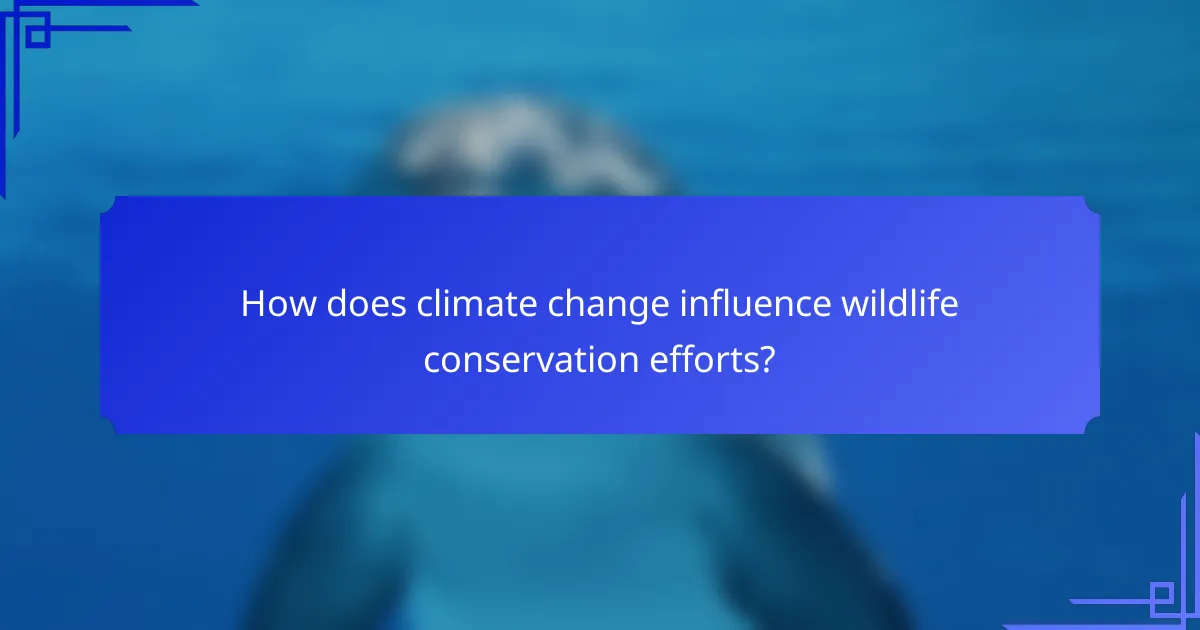
How does climate change influence wildlife conservation efforts?
Climate change significantly influences wildlife conservation efforts by altering habitats and species distributions. Rising temperatures and changing precipitation patterns affect ecosystems. Many species are forced to migrate to survive, leading to shifts in biodiversity. Conservation strategies must adapt to these changes to remain effective. For instance, protected areas may need to be relocated. Additionally, climate change increases the frequency of extreme weather events. These events can destroy habitats and disrupt conservation programs. Studies show that effective conservation requires integrating climate change projections into planning. This ensures long-term sustainability for wildlife populations.
What challenges do conservationists face due to climate change?
Conservationists face significant challenges due to climate change. These challenges include habitat loss, altered species distributions, and increased frequency of extreme weather events. Habitat loss occurs as rising temperatures and changing precipitation patterns affect ecosystems. Species are forced to migrate to cooler areas, disrupting existing ecosystems. Additionally, extreme weather events, such as floods and droughts, can destroy habitats and threaten wildlife. According to the Intergovernmental Panel on Climate Change (IPCC), these changes threaten biodiversity and the effectiveness of conservation efforts globally. Conservationists must adapt strategies to address these evolving threats to protect wildlife and their habitats.
How are conservation strategies adapting to changing climates?
Conservation strategies are adapting to changing climates by implementing flexible management practices. These practices include habitat restoration that accounts for future climate conditions. Additionally, conservationists are using climate modeling to predict shifts in species distributions. They are also promoting the establishment of wildlife corridors to facilitate species migration. Furthermore, adaptive management frameworks are being employed to allow for real-time adjustments in conservation efforts. These strategies are supported by research indicating that rapid climate change necessitates dynamic responses. For example, the Intergovernmental Panel on Climate Change emphasizes the need for proactive measures in biodiversity conservation.
What role does policy play in wildlife conservation amidst climate change?
Policy plays a crucial role in wildlife conservation amidst climate change. It establishes frameworks for protecting endangered species and habitats. Effective policies guide resource allocation for conservation efforts. They promote sustainable land use and habitat restoration initiatives. Policies also facilitate international cooperation on biodiversity protection. For example, the Convention on Biological Diversity sets global biodiversity targets. They help mitigate the impacts of climate change on wildlife. Additionally, policies can enforce regulations on pollution and habitat destruction. Overall, strong policies are essential for effective wildlife conservation in a changing climate.
Why is collaboration important in conservation efforts?
Collaboration is crucial in conservation efforts because it combines diverse expertise and resources. Effective conservation requires knowledge from various fields, such as biology, ecology, and policy-making. Collaboration fosters innovative solutions to complex environmental challenges. For instance, partnerships between governments, NGOs, and local communities can enhance project outcomes. Studies show that collaborative approaches lead to better resource management and increased biodiversity. According to the World Wildlife Fund, collaborative conservation initiatives have proven more effective in preserving endangered species. This collective effort amplifies impact and promotes sustainable practices across different regions.
How can local communities contribute to conservation initiatives?
Local communities can contribute to conservation initiatives by actively participating in local environmental projects. They can engage in habitat restoration efforts, such as planting native trees and removing invasive species. Community members can also educate others about the importance of biodiversity and conservation practices. By forming local conservation groups, they can advocate for policies that protect natural resources. Volunteering for clean-up events helps maintain healthy ecosystems. Additionally, communities can collaborate with organizations to monitor wildlife populations. These actions support the overall goal of preserving wildlife habitats affected by climate change. Research shows that community-led conservation efforts can lead to significant improvements in local biodiversity and ecosystem health.
What partnerships are essential for effective conservation?
Collaborations between governments, NGOs, and local communities are essential for effective conservation. Government partnerships provide funding and policy support. NGOs often bring expertise and resources to conservation projects. Local communities contribute traditional knowledge and stewardship of natural resources. Collaborative efforts increase the effectiveness of conservation strategies. Successful examples include the Amazon Fund, which involves multiple stakeholders in forest preservation. These partnerships lead to holistic approaches that address environmental challenges.
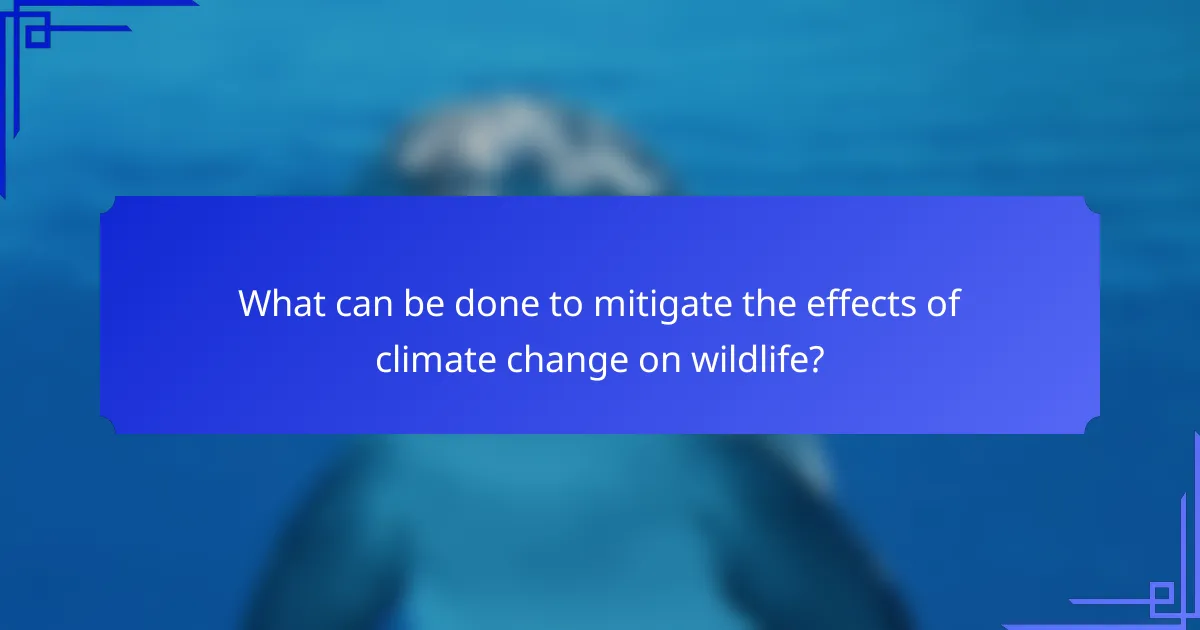
What can be done to mitigate the effects of climate change on wildlife?
Habitat conservation can mitigate the effects of climate change on wildlife. Protecting and restoring natural habitats helps maintain biodiversity. Establishing wildlife corridors allows species to migrate to suitable environments. Implementing sustainable land-use practices reduces habitat destruction. Reducing greenhouse gas emissions is essential for long-term climate stability. Supporting conservation programs enhances resilience against climate impacts. Engaging local communities in conservation efforts fosters stewardship. Education and awareness initiatives promote understanding of wildlife needs.
How can individuals contribute to wildlife conservation?
Individuals can contribute to wildlife conservation by engaging in sustainable practices. They can reduce their carbon footprint by using public transportation, biking, or walking. Supporting local conservation organizations through donations or volunteering also helps. Planting native trees and maintaining local gardens can provide habitats for wildlife. Reducing plastic use minimizes pollution that harms animal habitats. Participating in citizen science projects helps track wildlife populations and their health. Educating others about conservation issues raises awareness and encourages action. These actions collectively support biodiversity and mitigate the impacts of climate change on wildlife habitats.
What practices can reduce personal carbon footprints?
Reducing personal carbon footprints can be achieved through several practices. Individuals can minimize car travel by using public transportation, biking, or walking. This reduces greenhouse gas emissions significantly. Adopting a plant-based diet also lowers carbon footprints. According to a study by the University of Oxford, reducing meat consumption can cut individual emissions by up to 73%. Using energy-efficient appliances decreases electricity consumption. This can lead to lower carbon emissions from power plants. Additionally, reducing waste by recycling and composting can minimize landfill contributions. Landfills produce methane, a potent greenhouse gas. Finally, supporting renewable energy sources can help transition away from fossil fuels. Each of these practices contributes to a significant reduction in personal carbon footprints.
How can community initiatives support wildlife habitats?
Community initiatives can support wildlife habitats through conservation efforts, habitat restoration, and education. Local groups often organize clean-up events to remove debris from natural areas. This helps to maintain the health of ecosystems. Initiatives may also focus on planting native vegetation. Native plants provide food and shelter for local wildlife.
Additionally, community education programs raise awareness about the importance of biodiversity. These programs inform residents about local wildlife and conservation practices. Such knowledge encourages responsible behaviors that protect habitats. Collaboration with local governments can lead to better land-use policies. Effective policies can safeguard critical habitats from development pressures.
Research shows that community involvement enhances conservation outcomes. A study by the National Audubon Society found that local engagement leads to increased habitat protection. This indicates that community initiatives are vital for sustaining wildlife habitats.
What are the best practices for wildlife conservation in a changing climate?
Best practices for wildlife conservation in a changing climate include habitat protection, species monitoring, and adaptive management. Habitat protection involves preserving existing ecosystems and restoring degraded areas. This is crucial as ecosystems provide essential services for wildlife. Species monitoring helps track population changes and health, allowing for timely interventions. Adaptive management adjusts conservation strategies based on observed outcomes and changing conditions. Collaboration with local communities enhances conservation efforts by integrating traditional knowledge. Climate-resilient practices, such as creating wildlife corridors, facilitate species movement in response to habitat shifts. Research shows that these methods improve biodiversity outcomes in changing environments.
How can adaptive management enhance conservation outcomes?
Adaptive management enhances conservation outcomes by enabling flexible decision-making based on real-time data. This approach allows conservationists to adjust strategies as new information emerges. It fosters learning from both successes and failures in conservation practices. For instance, monitoring wildlife populations can inform changes in habitat management. Research shows that adaptive management can lead to more effective biodiversity preservation. A study by Williams et al. (2009) highlights its success in improving ecosystem resilience. This method promotes stakeholder engagement, ensuring diverse perspectives are considered. Overall, adaptive management is crucial for addressing the uncertainties posed by climate change in conservation efforts.
What role does education play in promoting conservation awareness?
Education plays a crucial role in promoting conservation awareness. It informs individuals about the importance of biodiversity and ecosystems. Educational programs can increase understanding of climate change impacts on wildlife habitats. Research shows that awareness leads to behavioral changes that support conservation efforts. For instance, studies indicate that educated communities are more likely to participate in conservation initiatives. Additionally, education fosters critical thinking skills necessary for addressing environmental challenges. Schools and organizations that focus on environmental education can effectively cultivate a culture of sustainability. Overall, education serves as a foundation for informed decision-making regarding conservation.
What steps can organizations take to improve conservation strategies?
Organizations can improve conservation strategies by adopting a multi-faceted approach. They should conduct comprehensive assessments of local ecosystems. This helps identify critical areas that need protection. Implementing sustainable land-use practices is essential. These practices minimize habitat destruction and promote biodiversity.
Engaging local communities in conservation efforts fosters collaboration. Community involvement ensures that conservation strategies are culturally relevant. Organizations should also invest in education and awareness programs. These programs inform the public about the importance of conservation.
Utilizing technology can enhance monitoring and data collection. Tools like satellite imagery and drones provide valuable insights into habitat changes. Collaborating with other organizations amplifies conservation efforts. Partnerships can lead to resource sharing and increased impact.
Finally, organizations must advocate for policies that support conservation. Strong environmental policies are crucial for long-term success. Collectively, these steps create a robust framework for improving conservation strategies.
The main entity of this article is the impact of climate change on wildlife habitats and conservation efforts. Climate change alters temperature and precipitation patterns, leading to habitat loss, decreased biodiversity, and increased competition among species. The article discusses the primary effects of climate change on ecosystems, the vulnerability of certain habitats, and the role of human activities in exacerbating these challenges. Additionally, it explores how conservation strategies are adapting to these changes and the importance of collaboration and education in addressing the threats posed by climate change to wildlife.
